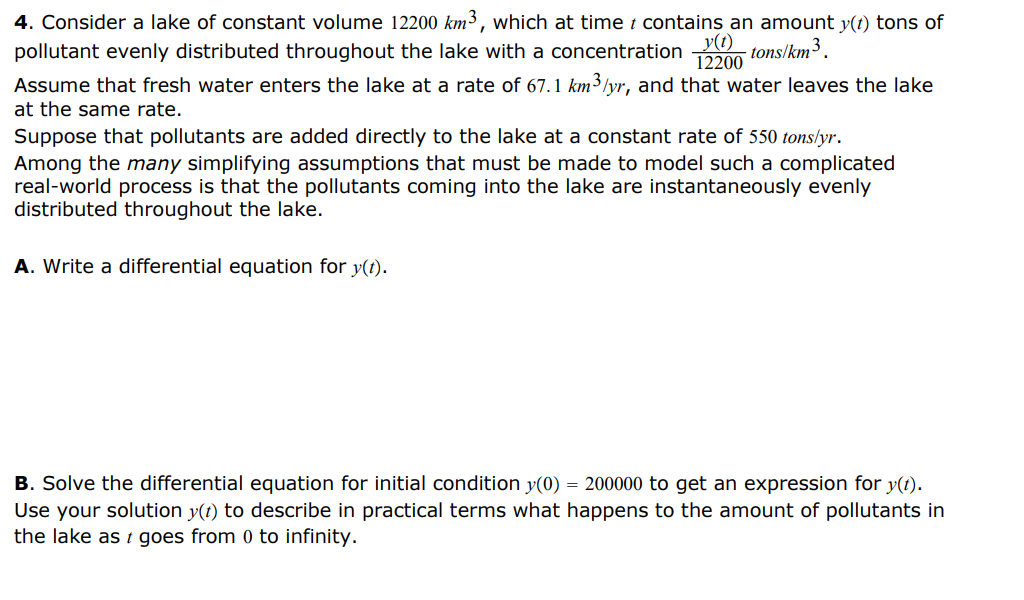4. Consider a lake of constant volume 12200 km³, which at time t contains an amount y(t) tons of pollutant evenly distributed throughout the lake with a concentration tons/km³. y(t) 12200 Assume that fresh water enters the lake at a rate of 67.1 km³/yr, and that water leaves the lake at the same rate. Suppose that pollutants are added directly to the lake at a constant rate of 550 tons/yr. Among the many simplifying assumptions that must be made to model such a complicated real-world process is that the pollutants coming into the lake are instantaneously evenly distributed throughout the lake. A. Write a differential equation for y(t). B. Solve the differential equation for initial condition y(0) = 200000 to get an expression for y(t). Use your solution y(t) to describe in practical terms what happens to the amount of pollutants in the lake as t goes from 0 to infinity.
4. Consider a lake of constant volume 12200 km³, which at time t contains an amount y(t) tons of pollutant evenly distributed throughout the lake with a concentration tons/km³. y(t) 12200 Assume that fresh water enters the lake at a rate of 67.1 km³/yr, and that water leaves the lake at the same rate. Suppose that pollutants are added directly to the lake at a constant rate of 550 tons/yr. Among the many simplifying assumptions that must be made to model such a complicated real-world process is that the pollutants coming into the lake are instantaneously evenly distributed throughout the lake. A. Write a differential equation for y(t). B. Solve the differential equation for initial condition y(0) = 200000 to get an expression for y(t). Use your solution y(t) to describe in practical terms what happens to the amount of pollutants in the lake as t goes from 0 to infinity.
Calculus: Early Transcendentals
8th Edition
ISBN:9781285741550
Author:James Stewart
Publisher:James Stewart
Chapter1: Functions And Models
Section: Chapter Questions
Problem 1RCC: (a) What is a function? What are its domain and range? (b) What is the graph of a function? (c) How...
Related questions
Question
Solve number 4

Transcribed Image Text:4. Consider a lake of constant volume 12200 km³, which at time i contains an amount y(t) tons of
y(t)
pollutant evenly distributed throughout the lake with a concentration
- tons/km³.
12200
Assume that fresh water enters the lake at a rate of 67.1 km³/yr, and that water leaves the lake
at the same rate.
Suppose that pollutants are added directly to the lake at a constant rate of 550 tons/yr.
Among the many simplifying assumptions that must be made to model such a complicated
real-world process is that the pollutants coming into the lake are instantaneously evenly
distributed throughout the lake.
A. Write a differential equation for y(t).
B. Solve the differential equation for initial condition y(0) = 200000 to get an expression for y(t).
Use your solution y(t) to describe in practical terms what happens to the amount of pollutants in
the lake as t goes from 0 to infinity.
Expert Solution
This question has been solved!
Explore an expertly crafted, step-by-step solution for a thorough understanding of key concepts.
This is a popular solution!
Trending now
This is a popular solution!
Step by step
Solved in 2 steps with 2 images

Recommended textbooks for you

Calculus: Early Transcendentals
Calculus
ISBN:
9781285741550
Author:
James Stewart
Publisher:
Cengage Learning

Thomas' Calculus (14th Edition)
Calculus
ISBN:
9780134438986
Author:
Joel R. Hass, Christopher E. Heil, Maurice D. Weir
Publisher:
PEARSON

Calculus: Early Transcendentals (3rd Edition)
Calculus
ISBN:
9780134763644
Author:
William L. Briggs, Lyle Cochran, Bernard Gillett, Eric Schulz
Publisher:
PEARSON

Calculus: Early Transcendentals
Calculus
ISBN:
9781285741550
Author:
James Stewart
Publisher:
Cengage Learning

Thomas' Calculus (14th Edition)
Calculus
ISBN:
9780134438986
Author:
Joel R. Hass, Christopher E. Heil, Maurice D. Weir
Publisher:
PEARSON

Calculus: Early Transcendentals (3rd Edition)
Calculus
ISBN:
9780134763644
Author:
William L. Briggs, Lyle Cochran, Bernard Gillett, Eric Schulz
Publisher:
PEARSON

Calculus: Early Transcendentals
Calculus
ISBN:
9781319050740
Author:
Jon Rogawski, Colin Adams, Robert Franzosa
Publisher:
W. H. Freeman


Calculus: Early Transcendental Functions
Calculus
ISBN:
9781337552516
Author:
Ron Larson, Bruce H. Edwards
Publisher:
Cengage Learning